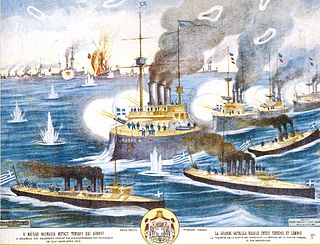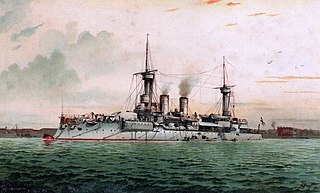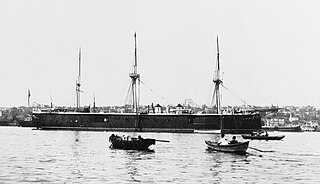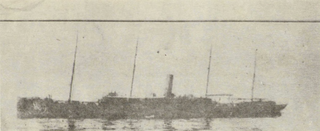
The Battle of Lemnos, fought on 18 January [O.S. 5 January] 1913, was a naval battle during the First Balkan War, in which the Greeks defeated the second and last attempt of the Ottoman Empire to break the Greek naval blockade of the Dardanelles and reclaim supremacy over the Aegean Sea. This, the final naval battle of the First Balkan War, forced the Ottoman Navy to retreat to its base within the Dardanelles, from which it did not venture for the rest of the war, thus ensuring the dominion of the Aegean Sea and the Aegean islands by Greece.

SMS Kurfürst Friedrich Wilhelm was one of the first ocean-going battleships of the German Kaiserliche Marine. The ship was named for Prince-elector Friedrich Wilhelm, 17th-century Duke of Prussia and Margrave of Brandenburg. She was the fourth pre-dreadnought of the Brandenburg class, along with her sister ships Brandenburg, Weissenburg, and Wörth. She was laid down in 1890 in the Imperial Dockyard in Wilhelmshaven, launched in 1891, and completed in 1893. The Brandenburg-class battleships carried six large-caliber guns in three twin turrets, as opposed to four guns in two turrets, as was the standard in other navies.

The Islamic Army of the Caucasus was a military unit of the Ottoman Empire formed on July 10, 1918. The Ottoman Minister of War, Enver Pasha, ordered its establishment, and it played a major role during the Caucasus Campaign of World War I.

SMS Weissenburg was one of the first ocean-going battleships of the Imperial German Navy. She was the third pre-dreadnought of the Brandenburg class, which also included her sister ships Brandenburg, Wörth, and Kurfürst Friedrich Wilhelm. Weissenburg was laid down in 1890 in the AG Vulcan dockyard in Stettin, launched in 1891, and completed in 1894. The Brandenburg-class battleships were unique for their era in that they carried six large-caliber guns in three twin turrets, as opposed to four guns in two turrets, as was the standard in other navies.

Mesudiye was a central-battery ironclad of the Ottoman Navy, one of the largest ships of that type ever built. She was built at the Thames Iron Works in Britain between 1871 and 1875. Mesudiye had one sister ship, though she was purchased by the Royal Navy and commissioned as HMS Superb. Her primary armament consisted of twelve 10-inch (250 mm) guns in a central armored battery.
A naval race had developed in the Aegean after the end of the Balkan Wars, with the Ottoman government ordering several ships, including two dreadnoughts, in Britain. In the event, with the outbreak of World War I, these ships, including further two scout cruisers and four destroyers, were confiscated and pressed into service with the Royal Navy. This disappointed the Ottomans, contributing to their joining the Central Powers in the Great War.

Muavenet-i Milliye or Muâvenet-i Millîye was a destroyer built for the Ottoman Navy prior to World War I. The ship is most notable for sinking the British pre-dreadnought battleship Goliath during the Dardanelles Campaign in World War I.
The Freedom and Accord Party, also known as the Liberal Union or the Liberal Entente, was a liberal Ottoman political party active between 1911 and 1913, during the Second Constitutional Era. It was the most significant opposition to Union and Progress in the Chamber of Deputies. The political programme of the party advocated for Ottomanism, government decentralisation, the rights of ethnic minorities, and close relations with Britain. In the post-1918 Ottoman Empire, the party became known for its attempts to suppress and prosecute the CUP.
This list includes fleet organisations of the Ottoman Navy during the Italo-Turkish War.
Thiolu

Berk-i Satvet was a torpedo cruiser of the Ottoman Navy, the second and final member of the Peyk-i Şevket class. She was built by the Germaniawerft shipyard in Germany in 1906–07, and was delivered to the Ottoman Navy in November 1907. The ship's primary armament consisted of three 450 mm (18 in) torpedo tubes and a pair of 105 mm (4.1 in) guns, and she was capable of a top speed of 21 knots. The ship's early career was uneventful; the Italo-Turkish War of 1911–12 passed without any action of the Ottoman fleet. Berk-i Satvet saw action during the Balkan Wars of 1912–13 in the Aegean and Black Seas, against Greek and Bulgarian opponents, respectively.

Mehmet Ali Ülgen was a Turkish admiral who served as commander-in-chief of the Turkish Naval Forces from 1 July 1949 to 6 June 1950. He joined the Navy in 1905 after graduating from the Turkish Naval Academy as ensign.

Şehzade Ibrahim Tevfik was an Ottoman prince, the son of Şehzade Mehmed Burhaneddin, and grandson of Sultan Abdulmejid I.

Yadigar-i Millet, originally built as SMS S166, was one of the four S138-class torpedo boats built for the German Imperial Navy, but was purchased by the Ottoman Navy National Support Association for the Ottoman Navy.
Nümune-i Hamiyet, originally built as SMS S167, was one of the four S138-class torpedo boats built for the German Imperial Navy, but was purchased for the Ottoman Navy during construction.
Gayret-i Vataniye originally built as SMS S168, was one of the four S138-class torpedo boats built for the German Imperial Navy, but was purchased for the Ottoman Navy during construction.

Yarhisar was one of the four Samsun-class destroyers, based on the Durandal class, purchased from France in 1907 by the Ottoman Navy Society. She joined the Ottoman Navy in 1907, but like the rest of the Ottoman fleet, she did not take part in any active engagement with the Italians during the Italo-Turkish war. During the Balkan Wars of 1912–1913, she took part in all major engagements such as the battles of Kaliakra, Elli and Lemnos, as well as patrol missions. During World War I, she took part in escort and interception missions, especially in the Sea of Marmara. She engaged in many battles with Allied submarines entering the Sea of Marmara. On December 3, 1915, she was torpedoed and sunk by HMS E11 off the coast of Yalova. 7 officers and 33 enlisted men were killed in the sinking. The submarine picked up the remaining crew from the sea and delivered them to an Ottoman sailing ship.

Draç was a torpedo boat of the Ottoman Navy that entered service in 1907. She took part in the Balkan Wars and World War I.

Samsun was one of the four Durandal-class destroyers purchased by the Ottoman Empire from France in 1907. The ship served in the Ottoman navy during the Tripoli War, the Balkan Wars and World War I.

Tirimüjgan, formerly Pembroke Castle, was a cargo ship launched in 1883 and purchased by the Ottoman Empire from the United Kingdom in 1906, requisitioned as a destroyer tender and used in the Italo-Turkish War, Balkan Wars and served during World War I.